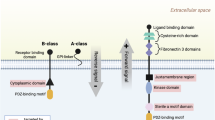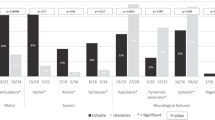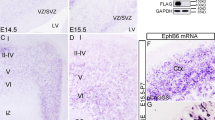Abstract
EphAs and ephrin-As have been implicated in the morphogenesis of the developing brain. We found that EphA7 and ephrin-A5 are coexpressed in the dorsal midline (DM) of the diencephalon and anterior mesencephalon. Interestingly, programmed cell death (PCD) of the neural epithelial cells normally found in this region was reduced in ephrin-A5/ephrin-A2 dual-deficient embryos. In contrast, in vivo expression of ephrin-A5-Fc or full-length ephrin-A5 strongly induced apoptosis in neural epithelial cells and was accompanied by severe brain malformation during embryonic development. Expression of ephrinA5-Fc correlated with apoptosis of EphA7-expressing cells, whereas null mutation of ephrin-A5 resulted in the converse phenotype. Importantly, null mutation of caspase-3 or endogenous ephrin-A5 attenuated the PCD induced by ectopically overexpressed ephrin-A5. Together, our results suggest that brain region-specific PCD may occur in a region where EphAs cluster with neighboring ephrin-As through cell–cell contact.
Similar content being viewed by others
Log in or create a free account to read this content
Gain free access to this article, as well as selected content from this journal and more on nature.com
or
Abbreviations
- BAC:
-
bacterial artificial chromosome
- BrdU:
-
5-bromo-2′-deoxyuridine
- DM:
-
dorsal midline
- DR5:
-
death receptor 5
- EGF:
-
epidermal growth factor
- Eph:
-
erythropoietin-producing hepatocellular kinase
- ephrin:
-
Eph receptor interacting proteins
- FADD:
-
Fas-associated death domain
- GFP:
-
green fluorescent protein
- NEC:
-
neural epithelial cell
- NGF:
-
nerve growth factor
- NTC:
-
neural tube closure
- NTCD:
-
neural tube closure defect
- PCD:
-
programmed cell death
- PCR:
-
polymerase chain reaction
- p75NTR:
-
p75 neurotrophin receptor
- RTK:
-
receptor tyrosine kinase
- TNFR-1:
-
tumor necrosis factor receptor 1
- Trk:
-
tropomyosin receptor kinase
- TUNEL:
-
terminal deoxynucleotidyl transferase-mediated dUTP nick end labeling
- X-gal:
-
5-bromo-4-chloro-3-indolyl-β-D-galactopyranoside
References
Homma S, Yaginuma H, Oppenheim RW . Programmed cell death during the earliest stages of spinal cord development in the chick embryo: a possible means of early phenotypic selection. J Comp Neurol 1994; 345: 377–395.
de la Rosa EJ, de Pablo F . Cell death in early neural development: beyond the neurotrophic theory. Trends Neurosci 2000; 23: 454–458.
Kuan CY, Roth KA, Flavell RA, Rakic P . Mechanisms of programmed cell death in the developing brain. Trends Neurosci 2000; 23: 291–297.
Yeo W, Gautier J . Early neural cell death: dying to become neurons. Dev Biol 2004; 274: 233–244.
Buss RR, Sun W, Oppenheim RW . Adaptive roles of programmed cell death during nervous system development. Annu Rev Neurosci 2006; 29: 1–35.
Vermeulen K, Berneman ZN, Van Bockstaele DR . Cell cycle and apoptosis. Cell Prolif 2003; 36: 165–175.
Snider WD . Functions of the neurotrophins during nervous system development: what the knockouts are teaching us. Cell 1994; 77: 627–638.
Raff MC . Social controls on cell survival and cell death. Nature 1992; 356: 397–400.
Flanagan JG, Vanderhaeghen P . The ephrins and Eph receptors in neural development. Annu Rev Neurosci 1998; 21: 309–345.
O’Leary DD, Wilkinson DG . Eph receptors and ephrins in neural development. Curr Opin Neurobiol 1999; 9: 65–73.
Kullander K, Klein R . Mechanisms and functions of Eph and ephrin signalling. Nat Rev Mol Cell Biol 2002; 3: 475–486.
Pasquale EB . Eph receptor signalling casts a wide net on cell behaviour. Nat Rev Mol Cell Biol 2005; 6: 462–475.
Pasquale EB . Eph receptors and ephrins in cancer: bidirectional signalling and beyond. Nat Rev Cancer 2010; 10: 165–180.
Pitulescu ME, Adams RH . Eph/ephrin molecules – a hub for signaling and endocytosis. Genes Dev 2010; 24: 2480–2492.
Conover JC, Doetsch F, Garcia-Verdugo JM, Gale NW, Yancopoulos GD, Alvarez-Buylla A . Disruption of Eph/ephrin signaling affects migration and proliferation in the adult subventricular zone. Nat Neurosci 2000; 3: 1091–1097.
Holmberg J, Armulik A, Senti KA, Edoff K, Spalding K, Momma S et al. Ephrin-A2 reverse signaling negatively regulates neural progenitor proliferation and neurogenesis. Genes Dev 2005; 19: 462–471.
Depaepe V, Suarez-Gonzalez N, Dufour A, Passante L, Gorski JA, Jones KR et al. Ephrin signalling controls brain size by regulating apoptosis of neural progenitors. Nature 2005; 435: 1244–1250.
Li X, Johnson RW, Park D, Chin-Sang I, Chamberlin HM . Somatic gonad sheath cells and Eph receptor signaling promote germ-cell death in C. elegans. Cell Death Differ 2012; 19: 1080–1089.
Lim YS, McLaughlin T, Sung TC, Santiago A, Lee KF, O’Leary DD . p75(NTR) mediates ephrin-A reverse signaling required for axon repulsion and mapping. Neuron 2008; 59: 746–758.
Marler KJ, Becker-Barroso E, Martinez A, Llovera M, Wentzel C, Poopalasundaram S et al. A TrkB/EphrinA interaction controls retinal axon branching and synaptogenesis. J Neurosci 2008; 28: 12700–12712.
Poopalasundaram S, Marler KJ, Drescher U . EphrinA6 on chick retinal axons is a key component for p75(NTR)-dependent axon repulsion and TrkB-dependent axon branching. Mol Cell Neurosci 2011; 47: 131–136.
Kumar S . Caspase function in programmed cell death. Cell Death Differ 2007; 14: 32–43.
Kuida K, Zheng TS, Na S, Kuan C, Yang D, Karasuyama H et al. Decreased apoptosis in the brain and premature lethality in CPP32-deficient mice. Nature 1996; 384: 368–372.
Kuida K, Haydar TF, Kuan CY, Gu Y, Taya C, Karasuyama H et al. Reduced apoptosis and cytochrome c-mediated caspase activation in mice lacking caspase 9. Cell 1998; 94: 325–337.
Hakem R, Hakem A, Duncan GS, Henderson JT, Woo M, Soengas MS et al. Differential requirement for caspase 9 in apoptotic pathways in vivo. Cell 1998; 94: 339–352.
Pompeiano M, Blaschke AJ, Flavell RA, Srinivasan A, Chun J . Decreased apoptosis in proliferative and postmitotic regions of the Caspase 3-deficient embryonic central nervous system. J Comp Neurol 2000; 423: 1–12.
Yeh WC, Pompa JL, McCurrach ME, Shu HB, Elia AJ, Shahinian A et al. FADD: essential for embryo development and signaling from some, but not all, inducers of apoptosis. Science 1998; 279: 1954–1958.
Varfolomeev EE, Schuchmann M, Luria V, Chiannilkulchai N, Beckmann JS, Mett IL et al. Targeted disruption of the mouse Caspase 8 gene ablates cell death induction by the TNF receptors, Fas/Apo1, and DR3 and is lethal prenatally. Immunity 1998; 9: 267–276.
Zhang J, Cado D, Chen A, Kabra NH, Winoto A . Fas-mediated apoptosis and activation-induced T-cell proliferation are defective in mice lacking FADD/Mort1. Nature 1998; 392: 296–300.
Juo P, Kuo CJ, Yuan J, Blenis J . Essential requirement for caspase-8/FLICE in the initiation of the Fas-induced apoptotic cascade. Curr Biol 1998; 8: 1001–1008.
Los M, Wesselborg S, Schulze-Osthoff K . The role of caspases in development, immunity, and apoptotic signal transduction: lessons from knockout mice. Immunity 1999; 10: 629–639.
Kaiser WJ, Upton JW, Long AB, Livingston-Rosanoff D, Daley-Bauer LP, Hakem R et al. RIP3 mediates the embryonic lethality of caspase-8-deficient mice. Nature 2011; 471: 368–372.
Peter ME . Programmed cell death: apoptosis meets necrosis. Nature 2011; 471: 310–312.
Zhang G, Njauw CN, Park JM, Naruse C, Asano M, Tsao H . EphA2 is an essential mediator of UV radiation-induced apoptosis. Cancer Res 2008; 68: 1691–1696.
Holmberg J, Clarke DL, Frisen J . Regulation of repulsion versus adhesion by different splice forms of an Eph receptor. Nature 2000; 408: 203–206.
Copp AJ, Greene ND, Murdoch JN . The genetic basis of mammalian neurulation. Nat Rev Genet 2003; 4: 784–793.
Gale NW, Holland SJ, Valenzuela DM, Flenniken A, Pan L, Ryan TE et al. Eph receptors and ligands comprise two major specificity subclasses and are reciprocally compartmentalized during embryogenesis. Neuron 1996; 17: 9–19.
Flenniken AM, Gale NW, Yancopoulos GD, Wilkinson DG . Distinct and overlapping expression patterns of ligands for Eph-related receptor tyrosine kinases during mouse embryogenesis. Dev Biol 1996; 179: 382–401.
Yoo S, Kim Y, Noh H, Lee H, Park E, Park S . Endocytosis of EphA receptors is essential for the proper development of the retinocollicular topographic map. EMBO J 2011; 30: 1593–1607.
Kim Y, Park S . Identification of EphA7 BAC clone containing a long-range dorsal midline-specific enhancer. BMB Rep 2011; 44: 113–117.
Himanen JP, Saha N, Nikolov DB . Cell-cell signaling via Eph receptors and ephrins. Curr Opin Cell Biol 2007; 19: 534–542.
Coulthard MG, Duffy S, Down M, Evans B, Power M, Smith F et al. The role of the Eph-ephrin signalling system in the regulation of developmental patterning. Int J Dev Biol 2002; 46: 375–384.
Carvalho RF, Beutler M, Marler KJ, Knoll B, Becker-Barroso E, Heintzmann R et al. Silencing of EphA3 through a cis interaction with ephrinA5. Nat Neurosci 2006; 9: 322–330.
Kao TJ, Kania A . Ephrin-mediated cis-attenuation of Eph receptor signaling is essential for spinal motor axon guidance. Neuron 2011; 71: 76–91.
Marquardt T, Shirasaki R, Ghosh S, Andrews SE, Carter N, Hunter T et al. Coexpressed EphA receptors and ephrin-A ligands mediate opposing actions on growth cone navigation from distinct membrane domains. Cell 2005; 121: 127–139.
Davis S, Gale NW, Aldrich TH, Maisonpierre PC, Lhotak V, Pawson T et al. Ligands for EPH-related receptor tyrosine kinases that require membrane attachment or clustering for activity. Science 1994; 266: 816–819.
Mellitzer G, Xu Q, Wilkinson DG . Eph receptors and ephrins restrict cell intermingling and communication. Nature 1999; 400: 77–81.
Xu Q, Mellitzer G, Robinson V, Wilkinson DG . In vivo cell sorting in complementary segmental domains mediated by Eph receptors and ephrins. Nature 1999; 399: 267–271.
Brantley-Sieders DM, Zhuang G, Hicks D, Fang WB, Hwang Y, Cates JM et al. The receptor tyrosine kinase EphA2 promotes mammary adenocarcinoma tumorigenesis and metastatic progression in mice by amplifying ErbB2 signaling. J Clin Invest 2008; 118: 64–78.
Weil M, Jacobson MD, Raff MC . Is programmed cell death required for neural tube closure? Curr Biol 1997; 7: 281–284.
Massa V, Savery D, Ybot-Gonzalez P, Ferraro E, Rongvaux A, Cecconi F et al. Apoptosis is not required for mammalian neural tube closure. Proc Natl Acad Sci USA 2009; 106: 8233–8238.
Chizhikov VV, Millen KJ . Roof plate-dependent patterning of the vertebrate dorsal central nervous system. Dev Biol 2005; 277: 287–295.
Kim Y, Song E, Choi S, Park S . Engineering lacZ Reporter gene into an ephA8 bacterial artificial chromosome using a highly efficient bacterial recombination system. J Biochem Mol Biol 2007; 40: 656–661.
Zimmer G, Kastner B, Weth F, Bolz J . Multiple effects of ephrin-A5 on cortical neurons are mediated by SRC family kinases. J Neurosci 2007; 27: 5643–5653.
Shim S, Kim Y, Shin J, Kim J, Park S . Regulation of EphA8 gene expression by TALE homeobox transcription factors during development of the mesencephalon. Mol Cell Biol 2007; 27: 1614–1630.
Noh H, Park S . Ectopic expression of Ephrin-A5 under the EphA8 promoter at the anterior region of the superior colliculus. Exp Neurobiol 2010; 19: 49–53.
Chenn A, Walsh CA . Regulation of cerebral cortical size by control of cell cycle exit in neural precursors. Science 2002; 297: 365–369.
Acknowledgements
We are indebted to Jonas Frisen and Pierre Vanderhaeghen for ephrin-A5 knock-out mice and human ephrin-A5 cDNA, respectively. This work was supported by a grant (no. 2009-0083149) from National Research Foundation of Korea (NRF), a grant (no. 2009K001246) from Brain Research Center of the 21st Century Frontier Research Program funded by the Ministry of Education, Science and Technology, and a grant of the Korean Health Technology R&D Project, Ministry of Health & Welfare (A111706).
Author information
Authors and Affiliations
Corresponding author
Ethics declarations
Competing interests
The authors declare no conflict of interest.
Additional information
Edited by JM Hardwick
Supplementary information accompanies the paper on Cell Death and Differentiation website
Supplementary information
Rights and permissions
About this article
Cite this article
Park, E., Kim, Y., Noh, H. et al. EphA/ephrin-A signaling is critically involved in region-specific apoptosis during early brain development. Cell Death Differ 20, 169–180 (2013). https://doi.org/10.1038/cdd.2012.121
Received:
Revised:
Accepted:
Published:
Issue date:
DOI: https://doi.org/10.1038/cdd.2012.121
Keywords
This article is cited by
-
Ephrin-B2 paces neuronal production in the developing neocortex
BMC Developmental Biology (2020)
-
Zfp422 promotes skeletal muscle differentiation by regulating EphA7 to induce appropriate myoblast apoptosis
Cell Death & Differentiation (2020)
-
Decreased signalling of EphA4 improves functional performance and motor neuron survival in the SOD1G93A ALS mouse model
Scientific Reports (2018)
-
Dying to communicate: apoptotic functions of Eph/Ephrin proteins
Apoptosis (2018)
-
EphrinA5-EphA7 Complex Induces Apoptotic Cell Death Via TNFR1
Molecules and Cells (2013)



